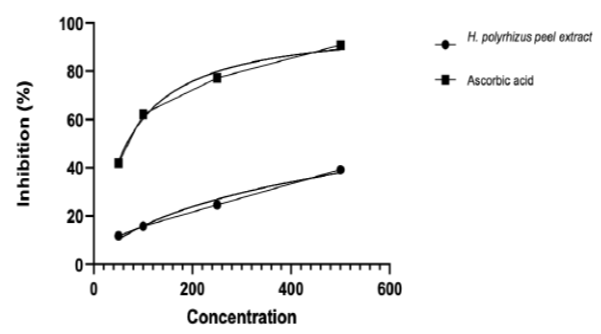


Indian Journal of Science and Technology
DOI: 10.17485/IJST/v14i14.2286
Year: 2021, Volume: 14, Issue: 14, Pages: 1097-1104
Original Article
Ma. Danica Ines Ramil1, Angelica May DC. Mendoza1,Rhian Jaymar D. Ramil1*
1Assistant Professors, Pharmacy Department, Mariano Marcos State University, City of Batac, Ilocos Norte, 2906, Philippines. Tel.: (+63) 927 733 9569
*Corresponding Author
Tel: (+63) 927 733 9569
Email: [email protected]
Received Date:22 December 2020, Accepted Date:31 March 2021, Published Date:26 April 2021
Background/Objectives: In the Philippines, Hylocereus polyrhizus is gaining upsurge interest due to its potential health benefits. Aside from the edible fruit pulp, various products from its peel are being developed, and claimed as health boosters. Thus, this study was conducted to assess the physicochemical characteristics, phytochemical constituents, nutritional and heavy metal contents and antioxidant activity of the peel of H. polyrhizus. Methods/Statistical analysis: Physicochemical and phytochemical screening were conducted following established protocols. Nutritional value and trace metals were measured with food analytical standard methods. Antioxidant activity was estimated using 2, 2-diphenyl-1-picrylhydrazyl (DPPH) and ferric reducing capacity (FRC) assays. Statistical analyses were carried out for DPPH and FRC assays using Graph-Pad Prism. Findings: Results showed that H. polyrhizus peel contains alkaloids, coumarins, flavonoids, phenols, and triterpenoids. Trace amounts of arsenic (0.022 mg/kg), lead (0.887 mg/kg), cadmium (0.068 mg/kg) and chromium (0.225 mg/kg) were detected which were all within the acceptable limit set by the WHO for herbal materials. H. polyrhizus peel contained 6.72% moisture, 14.7% ash, 0.526% total fat, 0.226% saturated fat, 3.73% total sugar, 4.28% crude protein, 73.8% total carbohydrate, and 63.2% total dietary fiber. Other nutrients detected are macronutrients such as K > Ca > Mg > Na, micronutrients Mn > Fe, and Vitamin C. Moreover, it exhibited remarkable antioxidant activity in terms of FRC assay and DPPH assay (IC50 = 986.8mg/mL). The present study results showed that H. polyrhizus peel could be used as a potentially rich source of nutrients and natural antioxidants. Thus, it can be developed as an ingredient for food and health products. Novelty/Applications: The preliminary data obtained provide information that could support the development of products from dragon fruit peel. The conversion of these wastes into utilizable natural health products would help in reducing environmental problems Ma. Danica Ines Ramil et al. / Indian Journal of Science and Technology 2021;14(14):1097–1104 associated with processing waste disposal.
Keywords: Antioxidant; Dragon Fruit Peel; Hylocereus polyrhizus; Phytochemical Screening; Nutritional Content; Heavy Metals
© 2021 Ma. Danica Ines Ramil et al.This is an open-access article distributed under the terms of the Creative Commons Attribution License, which permits unrestricted use, distribution, and reproduction in any medium, provided the original author and source are credited. Published By Indian Society for Education and Environment (iSee)
Subscribe now for latest articles and news.